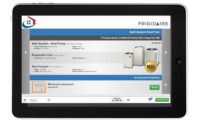When choosing refrigeration equipment for a new installation, the equipment is selected to provide the required refrigeration effect to either reduce and/or maintain a product’s temperature. This capacity is normally stated in Btuh. The unit cooler (evaporator), compressor, and metering device are all selected based on this Btuh requirement for the selected refrigerant. The only major component not selected based on this Btuh requirement is the condenser.
A condenser must be selected for the system’s total of heat rejection (THR), which is the sum of the heat energy absorbed by the evaporator and the additional heat energy added to the refrigerant by the compressor. This additional heat energy is referred to as the heat of compression. The heat of compression varies with the compressor design, so the compressor manufacturer’s information should be used whenever possible. If this information is not available, many condenser manufacturers will provide a reference table to determine that value.
Selecting an air-cooled condenser is not always necessary; many times, a condensing unit is selected for the installation. The condensing unit is selected based on the required Btuh capacity and its condenser is selected by the condensing unit manufacturer. However, systems using a remote air-cooled condenser will need to have the condenser chosen separately.
To begin the selection process, first determine the system’s THR by adding in the compressor’s heat of compression (obtained from either the compressor manufacturer or a table from the condenser manufacturer). If the condenser will be installed above sea level, a correction factor will need to be applied to the THR. The condenser manufacturer will generally have a table available providing the required correction factors.
Next, calculate the design temperature difference (TD), which is the design condensing temperature minus the design ambient temperature:
Design TD = Condensing temperature - Ambient temperature
Next, for the system’s refrigerant type, use the condenser manufacturer’s selection chart to choose the condenser based on the THR and at the design temperature difference. Some manufacturers’ charts may show their condenser’s capacity at a 1°F temperature difference. If necessary, you can determine the required TD at 1°F by dividing the THR by the design condenser TD:
THR/°TD = THR ÷ Calculated design condenser TD
If the required THR falls between two condenser capacities on the selection chart, chose the higher of the two. For example, you are selecting a remote air-cooled condenser for a system with a net refrigeration requirement of 225,000 Btuh. The condenser will be installed at sea level, so no factor for altitude correction is required. It is a low temperature system utilizing a R-404A semi-hermetic, suction cooled compressor with a design evaporating temperature of -20°F, an outdoor ambient of 90°F, and design condensing temperature of 110°F. According to the condenser manufacturer’s “Heat of Compression Factor for Suction Cooled Compressors” table, a multiplication factor of 1.55 should be used to determine the THR. Using this factor, the THR will be 348,750 Btuh (225,000 Btuh x 1.55). The design condenser TD will be 20°F (110°F - 90°F). Referencing the condenser manufacturer’s selection table for their R-404A condensers, it is possible to select the correct air-cooled condenser for the installation.
Selecting the correct air-cooled condenser for an installation is a vital part of ensuring the system operates properly and at peak efficiency.











